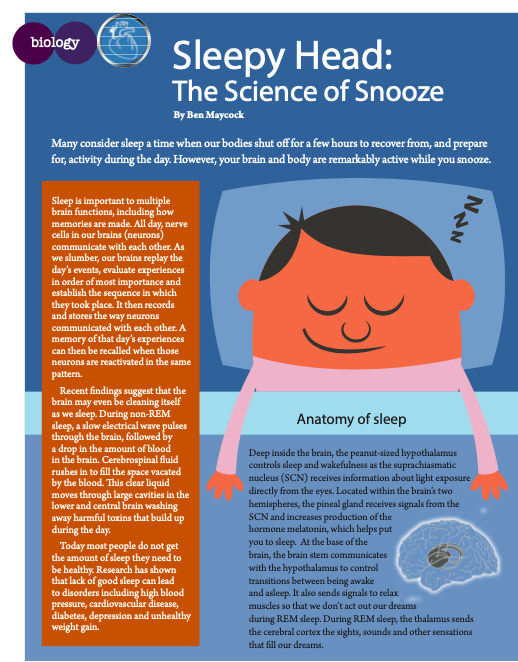
Many consider sleep a time when our bodies shut off for a few hours to recover from, and prepare for, activity during the day. However, your brain and body are remarkably active while you snooze.


Sleep is important to multiple brain functions, including how memories are made. All day, nerve cells in our brains (neurons) communicate with each other. As we slumber, our brains replay the day’s events, evaluate experiences in order of most importance and establish the sequence in which they took place. It then records and stores the way neurons communicated with each other. A memory of that day’s experiences can then be recalled when those neurons are reactivated in the same pattern.
Recent findings suggest that the brain may even be cleaning itself as we sleep. During non-REM sleep, a slow electrical wave pulses through the brain, followed by a drop in the amount of blood in the brain. Cerebrospinal fluid rushes in to fill the space vacated by the blood. This clear liquid moves through large cavities in the lower and central brain washing away harmful toxins that build up during the day.
Today most people do not get the amount of sleep they need to be healthy. Research has shown that lack of good sleep can lead to disorders including high blood pressure, cardiovascular disease, diabetes, depression and unhealthy weight gain.
Deep inside the brain, the peanut-sized hypothalamus controls sleep and wakefulness as the suprachiasmatic nucleus (SCN) receives information about light exposure directly from the eyes. Located within the brain’s two hemispheres, the pineal gland receives signals from the SCN and increases production of the hormone melatonin, which helps put you to sleep. At the base of the brain, the brain stem communicates with the hypothalamus to control transitions between being awake and asleep. It also sends signals to relax muscles so that we don’t act out our dreams during REM sleep. During REM sleep, the thalamus sends the cerebral cortex the sights, sounds and other sensations that fill our dreams.
The Four Stages of Sleep
During the night we experience two types of sleep: rapid eye movement (REM) sleep (which has one stage) and non-REM sleep (which has three different stages). A sleeper will cycle through all four stages several times during the night.
Stage 1 non-REM
Period from wakefulness to sleep.
Heartbeat, breathing and eye movements slow. Muscles relax with occasional twitches.
Brainwaves begin to slow from their daytime wakefulness patterns.
Stage 2 non-REM
Period of light sleep before entering deeper sleep.
Heartbeat and breathing slow. Muscles relax even further. Body temperature drops and eye movements stop.
Brainwave activity slows but is marked by brief bursts of electrical activity.
Stage 3 non-REM
Period of deep sleep.
Heartbeat and breathing slow to lowest levels during sleep. Muscles are relaxed. It is difficult to awaken sleeper.
Brainwaves become even slower.
REM Sleep
First occurs about 90 minutes after falling asleep. Most dreaming occurs at this stage.
Eyes move rapidly from side to side behind closed eyelids. Breathing becomes faster and irregular. Heart rate and
blood pressure increase to near waking levels.
Brainwave activity becomes closer to that seen in wakefulness.
Arm and leg muscles become temporarily paralyzed, preventing
sleeper from acting out dreams.
Fast Fact
We spend roughly
one third of our lives sleeping. Babies sleep as many as 18 hours a day, which helps with growth and development, especially of their brains. Children and teens need 9-10 hours of sleep, while adults need 7-9 hours.

